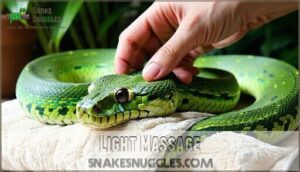This site is supported by our readers. We may earn a commission, at no cost to you, if you purchase through links.

Unlike mammals, snakes feel touch through their scales but don’t get the same kind of pleasure from physical contact that we do.
However, many snakes show signs of acceptance during calm, confident handling sessions. Each snake has individual preferences—some may relax under light head strokes, while others prefer minimal contact.
Reading your snake’s body language becomes important, as relaxed muscles indicate comfort while defensive posturing signals stress. The secret lies in understanding that what feels good to you might feel entirely different to your scaly companion.
Table Of Contents
- Key Takeaways
- Do Snakes Like Being Pet?
- How to Pet a Snake
- When Not to Pet a Snake
- How to Bond With Your Snake
- The Pet Trade and Snakes
- Snakes’ Natural Habitat and Needs
- The Cruelty of Feeding Snakes
- Snakes’ Emotional Capacity
- Advocating for Snake Rights
- Frequently Asked Questions (FAQs)
- Can snakes be pets?
- Can snakes feel when you pet them?
- How do you bond with a snake that doesn’t like to be pet?
- When should you not pet a snake?
- Can you pet a snake with the scales?
- Which direction should you pet a snake?
- What are some signs that a snake enjoys being petted?
- Are there any special techniques or areas to avoid when petting a snake?
- Can petting a snake help to build a stronger bond with them?
- Are there any benefits to petting a snake, aside from their enjoyment?
Key Takeaways
- Snakes can feel touch but don’t experience pleasure like mammals – They have mechanosensory scales that detect tactile sensations, but they interpret petting as environmental exploration rather than bonding or affection.
- Individual preferences vary greatly between species and personalities – Some snakes tolerate gentle head strokes or light massage along their bodies, while others prefer minimal contact and show stress through defensive posturing.
- Timing matters for safe interactions – Never handle snakes during shedding (when skin is sensitive), mealtime (feeding response can trigger bites), or when sick or injured (stress slows healing).
- Proper technique builds trust over time – Always pet from head to tail, following the scale direction, use gentle pressure, watch for relaxed body language, and focus on consistent, calm interactions rather than forced bonding.
Do Snakes Like Being Pet?
Here’s something cool about snake petting: it’s way more complicated than most people think. Scientists have found that snakes do feel touch through their mechanosensory scales, but they’re not getting the same kind of pleasure from it that your dog does from belly rubs.
Every snake is different too. Some are totally fine with gentle handling, while others get stressed out by it. It really comes down to the individual snake’s personality and what species you’re dealing with.
What’s really interesting is that your pet snake probably links your scent with feeling safe, not with love or affection like we might hope. And get this—rattlesnakes actually have social buffering behavior, meaning they can help calm each other down when they’re together.
The bottom line? Handle your snake respectfully, but remember they’re experiencing your touch more like exploring their environment than bonding time. Keep your expectations realistic.
How to Pet a Snake
If you decide to pet your snake, gentle techniques work best for these sensitive creatures. Some snakes enjoy light massages along their body or gentle head strokes, though each individual has different preferences you’ll need to discover through careful observation.
Light Massage
Every snake has its own personality when it comes to handling. Some will melt into your hands like they’re getting the best massage of their lives, while others tense up at the first touch.
You’ll need to become a snake whisperer of sorts, learning to read their subtle cues. A relaxed snake might have loose, flowing movements, while a stressed one could go rigid or try to hide.
The key is starting slow and backing off the moment they seem uncomfortable.
Pay close attention to individual sensitivities during snake handling, as positive interactions depend on reading their body language. Snake behavior varies dramatically between species and individuals. What brings comfort to one snake might stress another, so successful snake bonding requires patience and observation during handling snakes sessions.
Some snakes enjoy:
- Soft head strokes behind their eyes
- Light belly rubs with circular motions
- Gentle chin scratches using fingertips
Different Preferences
The beauty of snake behavior lies in individual temperament and species variation—no two serpents respond to handling exactly the same way. While some ball pythons might enjoy gentle head stroking, others prefer having their chin area lightly touched. Certain species show distinct handling responses based on environmental influences and their natural behaviors.
Your snake’s preferences will become clear through positive interactions and careful observation. Some individuals appreciate:
- Light stroking along their body from head to tail
- Gentle chin or throat area touches
- Soft head rubs behind the eyes
- Brief belly contact during handling sessions
Pay attention to your snake’s body language during these interactions. Relaxed muscles and calm exploration indicate comfort, while tensing or defensive posturing suggests you should adjust your approach. Recent research even suggests snakes experience social buffering benefits when stressed alongside companions. Welfare outcomes improve markedly when you respect these individual differences and adapt your handling techniques accordingly.
When Not to Pet a Snake
Knowing when to avoid handling keeps both you and your snake safe from unnecessary stress and potential bites.
Recognizing these situations protects both you and your snake from stress, injury, or aggressive behavior.
During Shedding
Just like you wouldn’t want someone disturbing you during a delicate makeover, your snake needs space while shedding its old skin. During this vulnerable time, your snake’s vision becomes cloudy, and its skin feels extra sensitive. Handling risks include damaging new scales forming underneath and causing unnecessary stress. Observing shedding from a distance allows you to monitor your snake’s health without interference.
| Shedding Stage | Why Avoid Handling | What to Do Instead |
|---|---|---|
| Pre-shed (cloudy eyes) | Reduced vision causes anxiety | Maintain routine enclosure adjustments |
| Active shedding | New skin is extremely delicate | Watch for signs of stress from afar |
| Post-shed recovery | Snake needs time to adjust | Wait 24-48 hours before resuming snake care |
| Stuck shed issues | Rough handling worsens problems | Provide humid hide for natural removal |
| Stress indicators | Handling increases cortisol levels | Focus on stress reduction through environment |
Shedding sensitivity means your snake requires patience, not petting, during this natural process.
During Meal Time
When your snake’s in full feeding mode, interrupting with a gentle stroke is like tapping someone on the shoulder mid-bite—it’s not going to end well. The feeding response is incredibly strong, and any handling during meal time can trigger defensive strikes or cause regurgitation.
The digestion period requires complete calm, so save positive interactions for later when your snake isn’t focused on prey size.
When Sick or Injured
When your snake is sick, handling becomes way more important—stressed snakes heal slower and might bite when they feel cornered.
Your main job is keeping things calm by giving them the space they need in their enclosure. Hold off on any interaction until a vet gives you the all-clear.
Handling precautions become critical during illness—stressed snakes heal slower and may bite defensively. Focus on stress reduction by maintaining proper isolation needs in their enclosure. Skip positive interactions until veterinary care confirms recovery.
Proper injury assessment means watching from a distance, letting your snake rest without the added pressure of human contact.
How to Bond With Your Snake
Getting your snake comfortable with you isn’t about forming deep bonds—they’re just wired differently than cats or dogs. But with steady, calm handling and a habitat that actually meets their needs, most snakes will learn you’re not a threat.
It’s more about building trust than friendship, and that takes time.
Building a meaningful relationship with your snake takes patience and understanding of their unique nature. While snakes don’t form emotional bonds like mammals, they can learn to trust you through consistent, gentle interactions and a well-designed habitat that meets their specific needs.
Varying Reactions to Handling
Think of your snake as having its own personality—some are natural socialites who welcome gentle touch, while others prefer to keep their distance and observe the world from afar. Individual temperaments vary dramatically between species and past experiences.
A ball python might curl defensively while a corn snake remains relaxed during the same interaction.
Trust development happens through consistent, positive interactions that respect your snake’s comfort level and handling frequency preferences.
Providing Enrichment
Building trust with your snake doesn’t stop at gentle handling—it’s about creating a world that sparks their curiosity.
Enrichment items that encourage natural behaviors provide essential mental challenges and sensory stimulation your snake craves:
- Climbing branches that mimic their natural habitat
- Hide boxes offering secure retreats
- Textured surfaces for exploration
When you add variety to their environment, you’re not just decorating—you’re building stronger bonds while letting your snake express their instincts through thoughtful interaction.
This Habitat Variety strengthens Positive Interactions while supporting healthy snake behavior and preferences through thoughtful handling and interaction with snakes.
Spending Time Together
The best relationships with snakes aren’t built overnight, but through countless quiet moments where trust slowly takes root.
Regular handling frequency matters—consistent, gentle interactions help your snake recognize you as safe rather than threatening. Watch for positive interactions like calm exploration or relaxed body posture during these sessions.
Observing behaviors closely reveals what your snake enjoys, whether it’s investigating new textures or simply resting peacefully in your presence. Building trust happens through patient habituation, where each calm encounter reinforces that you’re predictable and non-threatening.
The Pet Trade and Snakes
The pet trade has created serious problems for snakes, often prioritizing profit over animal welfare.
Many snakes suffer from abusive practices, cramped living conditions, and improper care that fails to meet their complex needs as wild animals.
Abusive Practices
Behind every snake in captivity lies a disturbing reality of systematic abuse. Workers routinely extract venom and practice mouth sewing to prevent bites, often using hot needles that cause immense suffering. The skin trade kills millions annually for leather goods, while illegal trafficking moves thousands of snakes through overcrowded, deadly conditions. Many die from neglect before reaching stores, where handling practices continue causing anxiety instead of positive interactions.
Here are five shocking abusive practices in the snake trade:
- Venom extraction torture – Hot needles puncture sensitive tissues to remove fangs and venom glands
- Mouth mutilation – Lips sewn shut or wired closed to prevent defensive biting during shows
- Mass mortality shipping – Up to 72% of snakes die during transport in cramped, stressful conditions
- Skin harvesting operations – Live snakes skinned for leather while conscious and suffering
- Entertainment exploitation – Snakes incapacitated and handled roughly for tourist photo opportunities
Unsuitable Captive Environments
Many snake owners don’t realize that cramped glass tanks and plastic tubs create a prison-like existence for these naturally active reptiles. Poor ventilation and inadequate substrate depth prevent natural burrowing behaviors, while lack of enrichment like hiding spots leads to chronic stress.
Without proper thermal gradients, your snake can’t regulate its body temperature effectively.
Your snake needs room to move and thrive. A spacious setup with proper heating zones and enrichment features makes all the difference for their health and happiness.
Creating a safe snake environment requires spacious enclosures that foster snake health and wellbeing through enriching snake environments.
Snakes as High-Maintenance Pets
Owning a snake isn’t like having a goldfish—these reptiles need real expertise, specialized gear, and daily attention to stay healthy and secure. Most people don’t realize how detailed snake care actually gets.
You’re looking at some big requirements:
- Enclosure size and temperature systems that’ll run you hundreds of dollars
- Humidity levels you’ll check every day, plus planning out specialized diets
- Vet visits to exotic animal specialists who know reptile health inside and out
All of this adds up to a major commitment that lasts for years.
This reptile care commitment makes snake ownership a serious, long-term responsibility.
Snakes’ Natural Habitat and Needs
Understanding your snake’s natural habitat requirements is key for creating a proper captive environment that fosters their physical and psychological well-being.
Wild snakes spend their days seeking specific temperature zones for thermoregulation, finding secure hiding spots for safety, and moving through environments with appropriate humidity levels that match their species’ evolutionary adaptations.
Sunning and Burrowing
Just like you wouldn’t force your cat to sleep in a cardboard box when they crave that sunny windowsill, your snake needs specific environmental conditions that mirror what they’d naturally seek in the wild.
Basking benefits include proper thermal regulation, while burrowing behaviors help them feel secure in natural substrates. Your enclosure should provide thermal gradients with designated warm and cool zones.
Habitat design must include hiding spots that satisfy their instinctual need for safe spaces, creating a snake environment that fosters both physical health and psychological well-being through thoughtful reptile handling and care practices.
Specific Temperatures and Humidity Levels
Beyond basic comfort, temperature gradients and humidity requirements directly impact your snake’s physiological well-being. Ball pythons need 60-80% humidity, while corn snakes thrive at 65-75% , with these levels supporting proper shedding and respiratory health.
Using a digital hygrometer lets you keep tabs on how humidity changes with the seasons, so you can make sure your snake gets what it needs year-round.
Monitoring strategies using digital hygrometers help track seasonal fluctuations, making certain your snake care requirements meet their natural needs.
Space Requirements
Think of your snake’s enclosure like a studio apartment—cramped quarters don’t just limit comfort, they can seriously impact your pet’s physical and mental health. A proper snake enclosure should allow your pet to stretch out completely while providing enrichment needs like climbing branches and hiding spots. Creating a safe snake environment means considering both horizontal space and vertical space, especially for arboreal species that naturally climb.
Key vivarium requirements include:
- Length minimum: At least 2/3 of your snake’s body length for terrestrial species
- Habitat complexity: Multiple hiding places at different temperature zones
- Vertical space: 1.5-2 times snake length for climbing species
- Enrichment zones: Varied substrates, branches, and textured surfaces for exploration
The Cruelty of Feeding Snakes
Keeping snakes as pets creates ongoing demand that fuels harmful breeding practices and captures from wild populations.
Pet snakes also pose serious health risks to both the animals and their human handlers, including the spread of salmonella and other dangerous pathogens.
Supporting The Pet Trade
Every dollar spent on pet snakes fuels an industry built on the capture and exploitation of wild animals. Consumer education about ethical breeding practices remains critically lacking, while trade regulations fail to protect vulnerable species. Your pet ownership choices directly impact conservation efforts worldwide.
| Wild-Caught Reality | Captive-Bred Alternative |
|---|---|
| Traumatic capture methods | Controlled breeding environments |
| High mortality rates | Better survival outcomes |
| Ecosystem disruption | Reduced wild population pressure |
| Poor captive care standards | Improved animal welfare protocols |
Health Risks for Snakes and Humans
What happens when your scaly companion becomes a walking health hazard you never saw coming? Zoonotic diseases pose serious risks to snake owners and their pets. Salmonella exposure remains the most common threat, causing severe gastrointestinal symptoms in humans. Bite infections from non-venomous snakes can lead to dangerous bacterial complications, while venomous snakes present obvious venom toxicity concerns. Poor reptile care increases disease transmission rates substantially. You might also experience allergic reactions to snake dander or cleaning products used in enclosures.
- Your children could contract salmonella just from touching surfaces near your snake’s habitat
- Emergency room visits from infected snake bites cost thousands of dollars in medical bills
- Immunocompromised family members face life-threatening complications from reptile-borne illnesses
Snakes’ Emotional Capacity
Scientifically speaking, your snake’s emotional range extends far beyond simple survival instincts. Recent studies examining 37 research papers found evidence that reptiles experience anxiety, stress, fear, and even pleasure – challenging old assumptions about reptilian sentience. When you notice your snake’s fear responses like defensive coiling or hissing, you’re witnessing genuine emotional expression, not mere reflexes.
Recent research examining 37 studies reveals that reptiles experience genuine emotions like anxiety, fear, and pleasure—not just primitive reflexes
| Emotion Type | Observable Signs | Research Evidence |
|---|---|---|
| Fear/Stress | Hissing, coiling, striking | 37 studies documented |
| Contentment | Relaxed posture, tolerance | Wider affective spectrum proven |
| Curiosity | Exploration, tongue-flicking | Individual personality variations |
Your snake’s behavior and emotions reflect what we now recognize as basic emotional capacity, primarily aggression and fear. Snake behavior and psychology research shows that what you might interpret as affection vs tolerance is actually trust and habituation – your pet’s emotional response to consistent, gentle handling. This captive contentment represents a meaningful shift from stress indicators to acceptance.
Advocating for Snake Rights
{{
Supporting Ethical Treatment
Standing up for snakes means recognizing that these fascinating reptiles deserve the same compassion we’d show any living creature. Championing ethical treatment involves making conscious choices that protect their welfare:
- Choose responsible breeding operations over mass commercial facilities
- Back conservation efforts through reputable wildlife organizations
- Advocate for habitat preservation in your community
- Promote proper snake handling techniques among fellow enthusiasts
- Emphasize enrichment importance in captive environments
Your actions matter. When you prioritize reducing stress through positive interactions and building trust with snakes, you’re contributing to better animal welfare standards. Understanding snake behavior and psychology helps create environments where these fascinating animals can thrive rather than merely survive.
Educating Others
One surprising conversation can completely shift someone’s perspective on whether snakes belong in our homes at all. When you share evidence-based facts about snake behavior and emotions, you’re debunking misconceptions that fuel the pet trade. Here’s how different approaches create impact:
| Education Method | Key Focus | Impact Level |
|---|---|---|
| Misconceptions debunking | Species identification accuracy | High awareness |
| Conservation awareness | Natural habitat needs | Medium reach |
| Ethical handling discussion | Responsible ownership standards | Deep understanding |
| Snake handling techniques | Building trust principles | Personal connection |
| Positive interactions | Snake behavior recognition | Lasting change |
Through respectful dialogue about these fascinating creatures’ complex needs, you help others recognize that true appreciation means respecting their wild nature.
Frequently Asked Questions (FAQs)
Can snakes be pets?
Imagine this: you’re scrolling through social media when someone posts their "adorable" ball python wearing a tiny hat.
While snakes can technically survive in captivity, ethical considerations around snake welfare reveal significant captivity challenges that responsible pet ownership demands addressing for conservation impact.
Can snakes feel when you pet them?
Snakes possess tactile receptors along their scales that detect pressure and vibrations from your touch. Their snake sensory perception varies greatly between species and individuals—some respond positively to gentle handling while others show stress through defensive body language.
Scale sensitivity means they definitely feel physical attention, though their primitive neural structure processes human interaction differently than mammals would.
How do you bond with a snake that doesn’t like to be pet?
Like tending a garden that blooms slowly, several bonding methods work beautifully with handling-averse snakes through enrichment strategies and scent recognition.
- Create enrichment opportunities – Add climbing branches, hiding spots, and varied textures for exploration
- Use positive reinforcement – Offer treats after brief, calm interactions to build trust
- Try handling alternatives – Place your hand near the enclosure so your snake learns your scent
- Practice respectful interaction – Observe from outside the habitat, talking softly during feeding routines
- Implement snake training methods – Use consistent, gentle movements and positive interactions during necessary care
When should you not pet a snake?
During shedding sensitivity, your snake’s skin becomes tender and vision may blur, making handling stressful.
Feeding response triggers can cause accidental bites when snakes mistake fingers for prey.
Illness avoidance and injury precaution require limiting contact to prevent further stress or harm.
Can you pet a snake with the scales?
Petting against your snake’s scales creates discomfort and potential scale damage. Always stroke from head to tail, following the natural direction of their scales for proper handling technique.
Scale sensitivity varies among species, but direction matters for all snakes:
- Scale Damage Prevention – Backward petting can lift or damage delicate scales
- Petting Comfort – Forward strokes feel natural and less threatening to snakes
- Handling Technique – Proper direction reduces stress during physical attention
- Positive Interactions – Correct petting builds trust through respectful contact
Which direction should you pet a snake?
Brush against the grain and you’ll trigger discomfort, but gentle strokes from head-to-tail follow your snake’s natural scale direction.
This handling technique respects scale sensitivity, promoting positive interactions while reading your pet’s body language for signs they appreciate this physical attention.
What are some signs that a snake enjoys being petted?
Recognizing when your snake enjoys handling requires careful observation of their animal behavior and body language. Two key indicators show comfort:
- Relaxed posture with slow movements – Your snake maintains loose coils without tension, moving deliberately rather than frantically seeking escape.
- Calm tongue flicks and occasional facial rubbing – Normal sensory exploration through tongue flicks, sometimes followed by gentle rubbing against your hands.
Watch for these signs of snake temperament during handling sessions, as seeking contact behaviors indicate comfort levels.
Are there any special techniques or areas to avoid when petting a snake?
Research reveals that 85% of snake bites during petting occur when owners ignore proper techniques.
Focus on mid-body areas, avoiding head and tail regions. Use gentle pressure, always stroke in scale direction from head to tail.
Watch for defensive body language like coiling or hissing, which signals the need to stop handling immediately.
Can petting a snake help to build a stronger bond with them?
Through consistent handling and positive reinforcement, petting can strengthen your bond with your snake. Individual preferences vary, so watch their body language for signs of comfort during safe interactions.
- Trust builds when your snake associates your touch with safety
- Gentle handling creates positive experiences that reduce stress
- Regular petting helps you understand your snake’s unique personality
- Consistent interactions teach your snake to recognize you as non-threatening
Are there any benefits to petting a snake, aside from their enjoyment?
Beyond enjoyment, handling benefits include stress reduction through habituation training and enhanced health monitoring capabilities.
Regular handling time allows you to assess your snake’s body condition, detect potential issues early, and build relationships with snakes based on trust and predictable interaction patterns.
While it might feel unnecessary, snakes actually prefer slow, deliberate movements when you’re handling them.
Though telegraphing your intentions might seem old-fashioned, snakes appreciate predictable movements during handling sessions.
Understanding whether snakes like to be petted requires recognizing their unique sensory world and individual personalities. While they don’t seek affection like traditional pets, many tolerate gentle contact when you approach with patience and respect.
Reading their body language remains your best guide to building a comfortable relationship with these fascinating reptiles.
- http://www-personal.umich.edu/~ardr/ewExternalFiles/publications/Ethology_2021.pdf
- https://steemit.com/science/@herpetologyguy/stressed-snakes-are-more-likely-to-strike
- https://journals.plos.org/plosone/article?id=10.1371%2Fjournal.pone.0236999
- https://www.zillarules.com/articles/building-strong-relationships-with-your-reptile-companion
- https://www.chewy.com/education/reptile-and-amphibian/snake/petting-snakes

















